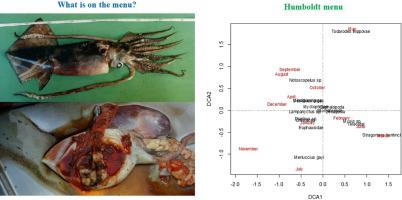当前位置:
X-MOL 学术
›
Fish. Res.
›
论文详情
Our official English website, www.x-mol.net, welcomes your feedback! (Note: you will need to create a separate account there.)
What is on the menu? Feeding, consumption and cannibalism in exploited stocks of the jumbo squid Dosidicus gigas in south-central Chile
Fisheries Research ( IF 2.4 ) Pub Date : 2021-01-01 , DOI: 10.1016/j.fishres.2020.105722 Claudia Bruno , Claudio F. Cornejo , Rodrigo Riera , Christian M. Ibáñez
Fisheries Research ( IF 2.4 ) Pub Date : 2021-01-01 , DOI: 10.1016/j.fishres.2020.105722 Claudia Bruno , Claudio F. Cornejo , Rodrigo Riera , Christian M. Ibáñez

|
Abstract Only few studies on the feeding and cannibalism behavior of the jumbo squid have been conducted in the Humboldt Current System despite this species is currently considered an important economic resource. It is possible that the diet of this ommastrephid squid varies throughout the year, among areas and body size. Therefore, we herein collected jumbo squids from commercial catches during January to December 2014 using purse-seine nets. The stomach contents were analyzed in terms of frequency of occurrence, number, and weight of prey items. The diet composition was analyzed using Detrended Correspondence Analysis. The variation of jumbo squid diet composition was evaluated from different biological and temporal predictors (sex, maturity, body size and months), considering and analyzing cannibalism. Daily ration was estimated using three methods to calculate consumption and consumption/biomass ratio. Our results suggest that there are significant differences in diet throughout the year, among sizes, and between sexes, however, no differences were found according to the interactions of these factors, except for the interaction between sex and month. In addition, significant differences were detected for each factor (sex, month and body size) when evaluating cannibalism, although these differences were only significant when factors were evaluated independently. Body size was the best predictor of diet composition, richness and cannibalism variation. Stomach content weight was highly biased due to the advanced level of digestion, which in turn biased the diet based on weight, daily ration and consumption analyses. In this sense, the bioenergetic model based on water temperature fitted better than models based on stomach content weight and body mass. These results showed that D. gigas mostly predates on crustaceans and cephalopods, which contrasts with most ecosystem models that suggest that this species highly predates on commercially-exploited fish species.
中文翻译:

菜单上有什么?智利中南部巨型鱿鱼 Dosidicus gigas 已开发种群的饲养、消费和同类相食
摘要 尽管巨型鱿鱼目前被认为是重要的经济资源,但在洪堡海流系统中对巨型鱿鱼的摄食和自相残杀行为的研究很少。这种 ommastrephid 鱿鱼的饮食可能在一年中因地区和体型而异。因此,我们在此使用围网收集了 2014 年 1 月至 12 月期间商业捕捞的巨型鱿鱼。根据发生频率、数量和猎物重量对胃内容物进行分析。使用去趋势对应分析来分析饮食组成。从不同的生物和时间预测因素(性别、成熟度、体型和月份)评估巨型鱿鱼饮食成分的变化,并考虑和分析同类相食。使用三种计算消耗量和消耗量/生物量比的方法估计每日定量。我们的结果表明,全年、大小和性别之间的饮食存在显着差异,但是,除了性别和月份之间的相互作用外,根据这些因素的相互作用没有发现差异。此外,在评估同类相食时,每个因素(性别、月份和体型)都检测到显着差异,尽管这些差异仅在独立评估因素时才显着。体型是饮食成分、丰富度和同类相食变化的最佳预测指标。由于先进的消化水平,胃内容物的重量有很大的偏差,这反过来又会根据体重、每日定量和消耗分析对饮食产生偏差。在这个意义上,基于水温的生物能模型比基于胃内容物重量和体重的模型更适合。这些结果表明,D. gigas 主要早于甲壳类和头足类动物,这与大多数生态系统模型形成对比,后者表明该物种高度早于商业开发的鱼类物种。
更新日期:2021-01-01
中文翻译:

菜单上有什么?智利中南部巨型鱿鱼 Dosidicus gigas 已开发种群的饲养、消费和同类相食
摘要 尽管巨型鱿鱼目前被认为是重要的经济资源,但在洪堡海流系统中对巨型鱿鱼的摄食和自相残杀行为的研究很少。这种 ommastrephid 鱿鱼的饮食可能在一年中因地区和体型而异。因此,我们在此使用围网收集了 2014 年 1 月至 12 月期间商业捕捞的巨型鱿鱼。根据发生频率、数量和猎物重量对胃内容物进行分析。使用去趋势对应分析来分析饮食组成。从不同的生物和时间预测因素(性别、成熟度、体型和月份)评估巨型鱿鱼饮食成分的变化,并考虑和分析同类相食。使用三种计算消耗量和消耗量/生物量比的方法估计每日定量。我们的结果表明,全年、大小和性别之间的饮食存在显着差异,但是,除了性别和月份之间的相互作用外,根据这些因素的相互作用没有发现差异。此外,在评估同类相食时,每个因素(性别、月份和体型)都检测到显着差异,尽管这些差异仅在独立评估因素时才显着。体型是饮食成分、丰富度和同类相食变化的最佳预测指标。由于先进的消化水平,胃内容物的重量有很大的偏差,这反过来又会根据体重、每日定量和消耗分析对饮食产生偏差。在这个意义上,基于水温的生物能模型比基于胃内容物重量和体重的模型更适合。这些结果表明,D. gigas 主要早于甲壳类和头足类动物,这与大多数生态系统模型形成对比,后者表明该物种高度早于商业开发的鱼类物种。


























 京公网安备 11010802027423号
京公网安备 11010802027423号